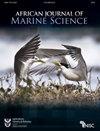Salt marsh erosion in a microtidal estuary
IF 1.4
4区 生物学
Q3 MARINE & FRESHWATER BIOLOGY
引用次数: 0
Abstract
Salt marshes protect estuary banks from erosion by acting as buffers between marine and terrestrial environments. Residents living near the Breede River estuary, Western Cape Province, South Africa, raised concerns about ongoing erosion evident at Groenpunt, the main salt marsh. This study aimed to determine how long erosion has been taking place, the rate and possible causes thereof. Aerial images and environmental data were assessed for the years 2002–2020. Erosion was first evident in 2003. By 2020, the marsh edge had been eroded into a series of micro-bays, incised horizontally up to 7 m, with a scarp height of 0.7 m, corresponding to a loss of 1 313 m2 of salt marsh and a bank retreat rate of 0.66 (SE 0.44) m year−1. Over the study period, there was a regular pattern of high-frequency gale-force winds (>8 on the Beaufort scale), with significantly more winds of this magnitude occurring in 2002 than in other years. The wind wave fetch adjacent to the marsh is up to 1 km in the direction of the predominant wind, and it is likely that the cumulative effects of constant wind-generated waves drove the erosion process. Estuary water and tidal levels over the period reflected normal seasonal fluctuation patterns. The bank supporting Groenpunt salt marsh is eroding at a rate that could possibly see it disappear within the next 60 years, reducing biodiversity and ecosystem services in the estuary. In the face of increasing climatic variability predicted in the future, similar salt marsh erosion is likely to become more prevalent.微潮河口的盐沼侵蚀
盐沼作为海洋和陆地环境之间的缓冲带,保护河口岸免受侵蚀。居住在南非西开普省布里德河河口附近的居民对主要盐沼Groenpunt的持续侵蚀表示担忧。这项研究旨在确定侵蚀发生的时间、速率和可能的原因。对2002-2020年的航空图像和环境数据进行了评估。侵蚀最早出现在2003年。到2020年,沼泽边缘已被侵蚀成一系列微湾,水平切割达7 m,崖高为0.7 m,相当于1 313 m2的盐沼损失和0.66 (SE 0.44) m的退缩率。在研究期间,有规律的高频大风模式(波弗特规模为bb80级),2002年发生的这种强度的风明显多于其他年份。沼泽附近的风浪向主导风方向移动可达1 km,可能是持续风浪的累积效应驱动了侵蚀过程。期间的河口水位和潮汐水平反映了正常的季节波动模式。支持格伦庞特盐沼的河岸正在以一种可能在未来60年内消失的速度受到侵蚀,从而减少了河口的生物多样性和生态系统服务。面对未来预测的日益增加的气候变化,类似的盐沼侵蚀可能会变得更加普遍。
本文章由计算机程序翻译,如有差异,请以英文原文为准。
求助全文
约1分钟内获得全文
求助全文
来源期刊

African Journal of Marine Science
生物-海洋与淡水生物学
CiteScore
2.60
自引率
16.70%
发文量
17
审稿时长
6-12 weeks
期刊介绍:
The African (formerly South African) Journal of Marine Science provides an international forum for the publication of original scientific contributions or critical reviews, involving oceanic, shelf or estuarine waters, inclusive of oceanography, studies of organisms and their habitats, and aquaculture. Papers on the conservation and management of living resources, relevant social science and governance, or new techniques, are all welcomed, as are those that integrate different disciplines. Priority will be given to rigorous, question-driven research, rather than descriptive research. Contributions from African waters, including the Southern Ocean, are particularly encouraged, although not to the exclusion of those from elsewhere that have relevance to the African context. Submissions may take the form of a paper or a short communication. The journal aims to achieve a balanced representation of subject areas but also publishes proceedings of symposia in dedicated issues, as well as guest-edited suites on thematic topics in regular issues.
 求助内容:
求助内容: 应助结果提醒方式:
应助结果提醒方式:


